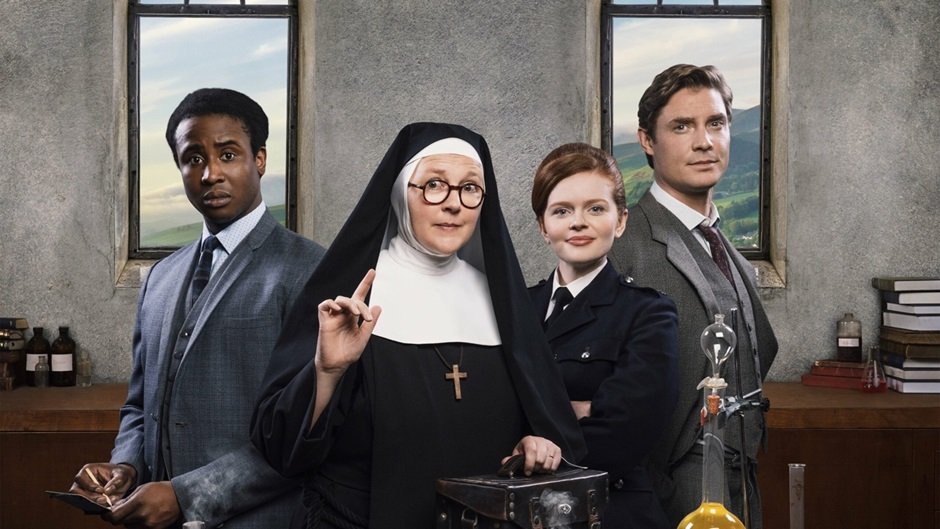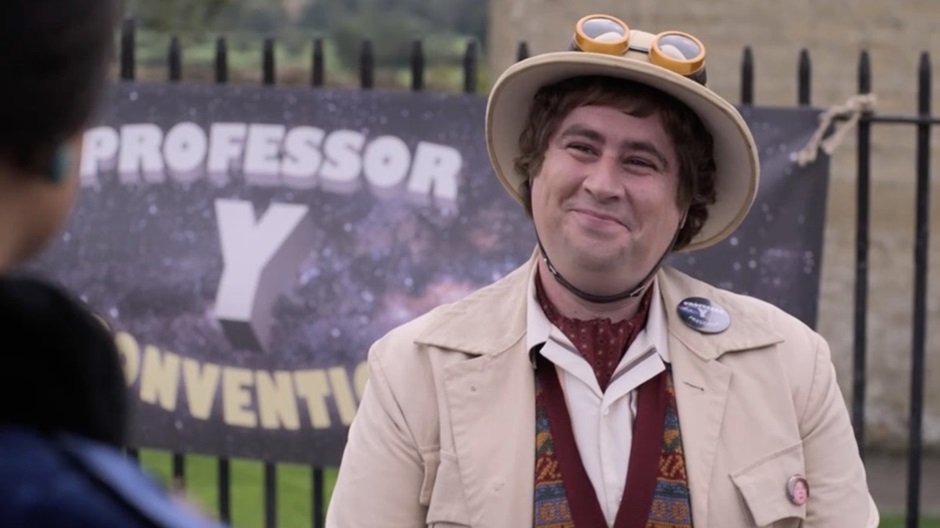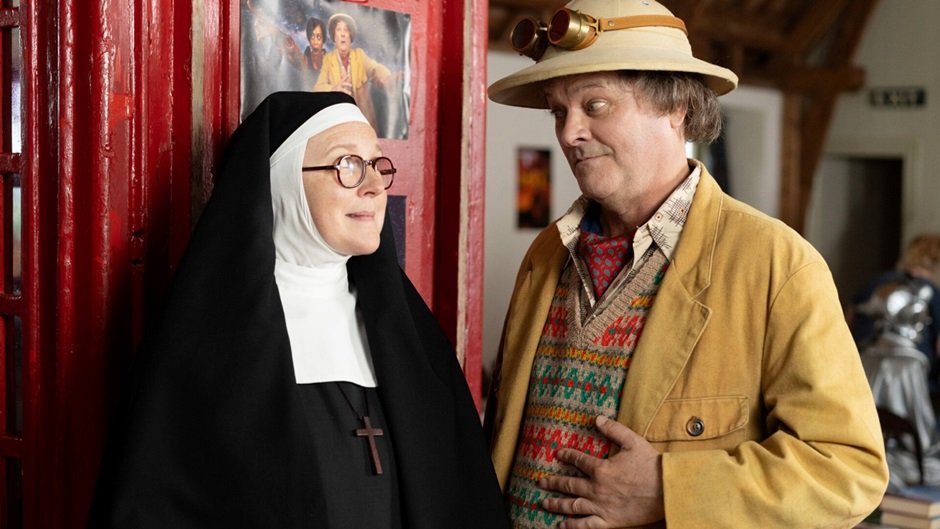In the beginning was Father Brown (Mark Williams) and for around a decade he would be solving the multitude of murders that were occurring during the 1950s in the Cotswolds village of Kembleford.
Like the Whoniverse, Father Brown begat its own: a Fatherbrowniverse as it were. Sister Boniface Mysteries became a sister show (pun intended). Indeed, the characters of Father Brown and Sister Boniface (Lorna Watson) have appeared in each other’s shows.
For those who have not seen it, Sister Boniface Mysteries is made by the U (formerly UKTV) network, which is partly BBC owned. This is also the network that has been keeping Red Dwarf alive.
An ensemble period/comedy/drama: Inspector Gillespie leads the local constabulary, with his second in command Sergeant Livingstone along with uniformed WPC Button. Sister Boniface completes the team as the forensic genius, as well as a local nun, and regularly cracks the case in her makeshift laboratory within St. Vincent’s Convent.

There are a handful of regulars that frequently appear: among them are Gillespie and Livingsone’s stern landlady, Mrs Clam; the farmer Tom Thomas, who no one can understand except Great Slaughter residents; and the dotty Mrs Thimble, Mrs Calm’s best friend, who is equally inept or a genius depending on the task she’s given.
No village would be complete without the local newspaper and its intrepid reporters: Norman Whalley, deeply in-love with WPC Button, sadly unreciprocated, who replaced Ruth Penny during season two (played by Big Finish Sixth Doctor assistant Mrs Constance Clarke, Miranda Raison).
Of course, there are also the nuns, Sister Peter, Sister Reginald, and battle-axe Reverend Mother Adrian who make frequent appearances; the nuns all taking the name of a saint when they join the sisterhood.
But where Father Brown is a more serious murder mystery thriller, and (originally) based on the G K Chesterton books, Sister Boniface Mysteries, created by Jude Tindall, is wholly original and very much more comedy based.
For a start, there is the name of the village where the series is set – Great Slaughter – a kind of knowing wink to the audience that a small village could accommodate so many murders, but it has to be said there are the more ‘serious’ episodes such as Sister Town where German soldiers visit Great Slaughter for a war memorial ceremony.
But what stands this above the crowd are the references and plot lines pertaining to 1960s pop culture, with the series set during that same decade. Just to give a flavour, some of the best ones have been:
In the episode Lights, Camera, Murder, the convent is being used to film an episode of TV spy series Operation QT where the style and stars of the show are suspiciously similar to The Avengers (that’s Steed, not Marvel).
The production team from children’s show Jolly Roger (do you see what they did there?) come to the village to devote a whole episode to Great Slaughter (Don’t Try This at Home). Biddy Baxter doesn’t come out of this very well…
The creator of a secret agent movie franchise is testing other actors to take over the role of Secret Agent Jonas Best (Never Too Deadly to Die), the favourite of which is a ‘television star’ who is quite obviously alluding to Roger Moore and The Saint.
The camp-comedy Oh Behave Constable is being filmed in Great Slaughter (A Tight Squeeze) where the five stars of the film are clearly Bernard Bresslaw, Sid James, Kenneth Williams, Hatti Jaques, and Barbara Windsor. Of course, they all have different names in this episode, but the actors cast here are so on the nose.

Following on from that selection, it was only a matter of time before 1960’s Doctor Who would be in the firing line. Finally, in season three, it landed with the episode, Professor Y.
The episode starts with a black and white sequence re-creating the TV series Professor Y, where a young woman runs across a field to a red telephone box, jumps in, and dials a number on the payphone. She is then teleported into a ‘console room’ where the Professor (Mark Heap) tries to launch the TWYDIS (at least, I think that’s what the Professor called it) but it has been invaded by a Zybok (suspiciously Dalekish) where it shoots the Professor…
Watching at home on his black and white television is Professor Y fan, Gillespie and he, and many of his team, are presently going to attend the world’s first Professor Y convention to be held in Great Slaughter by the Professor Y Appreciation Society.
Kirk Fabricant, the on-screen actor who plays Professor Y, arrives as does the obnoxious writer of the series, Douglas P Wiseman, who is ashamed of what he created and makes it known to the convention crowd. However, presently Wiseman disappears and all that is left of him is a pool of blood on the floor of his hotel room and the weapon used to hit him: his typewriter.
At this point, I will leave the plot as I don’t want to spoil the fun, but what struck me about the narrative of the episode were the numerous references to classic Who to a point where the viewer would have to be a long-standing Doctor Who fan to be in on them. Indeed, if the writer of the episode, series creator Jude Tindall, isn’t a Doctor Who fan, then she’s certainly done her homework on Classic Who.
But should I be surprised? The aforementioned James Bond episode Never Too Deadly to Die has a script which references Pussy Galore (wink emoji) and some very knowing comments; my favourite being a throwaway line about the previous Jonas Best actor wearing a toupee.
Some Doctor Who references from the episode to be going along with:
At the convention, led by a rather obnoxious PYAS president, the big scoop was to show the footage from the incomplete Power of the Zyboks which was never finished due to the “technician’s strike of 1961”. The Zybok name is even two references rolled into one!

Due to poor ratings, Professor Y had been cancelled with a cliffhanger ending, but there was a fan campaign to bring it back.
When Sister Boniface entered one of her dream states (she does this frequently), she appeared in the TWYDIS’s console room where she splutters, “Oh my giddy aunt!”
The Professor Y costume is very reminiscent of McCoy’s Seventh Doctor with added pith helmet and goggles, but the character has the enthusiasm of the Second Doctor rather than the more acerbic First. Although, his assistant, Celeste Carmichael, is rather more generic.
Plot-lines of this nature tend to be a little mocking of the enthusiastic fan, but I don’t recall the word ‘anorak’ being used throughout the episode. However, at one point, Wiseman, up on the stage at the convention, clearly looks down his nose at the convention crowd and sneers at, what he terms as, their sad little lives.
But the story does pull back from that. What it displays is the relationship that fans can have with their favourite programmes; there is the joy in people’s faces as they turn up at the convention dressed as aliens and characters, and it is quite clear that many of these people have taken inspiration from their favourite programme, including some of the Sister Boniface regulars.
It even presents, quite strongly, the value of escapism and that such can bring people through the most dreadful times of their lives. Escapism being something I wish modern Who would remember.
The episode is a delight from start to finish and even the end credits are given a Doctor Who pastiche where the Sister Boniface theme tune gets a Delia Derbyshire style makeover.
And rest assured, dear reader, there is no painful reference to any Professor Y episodes being wiped and considered lost.
Wonderful television.
Sister Boniface Mysteries is available on the UKTV Play website (now re-branded as U).


